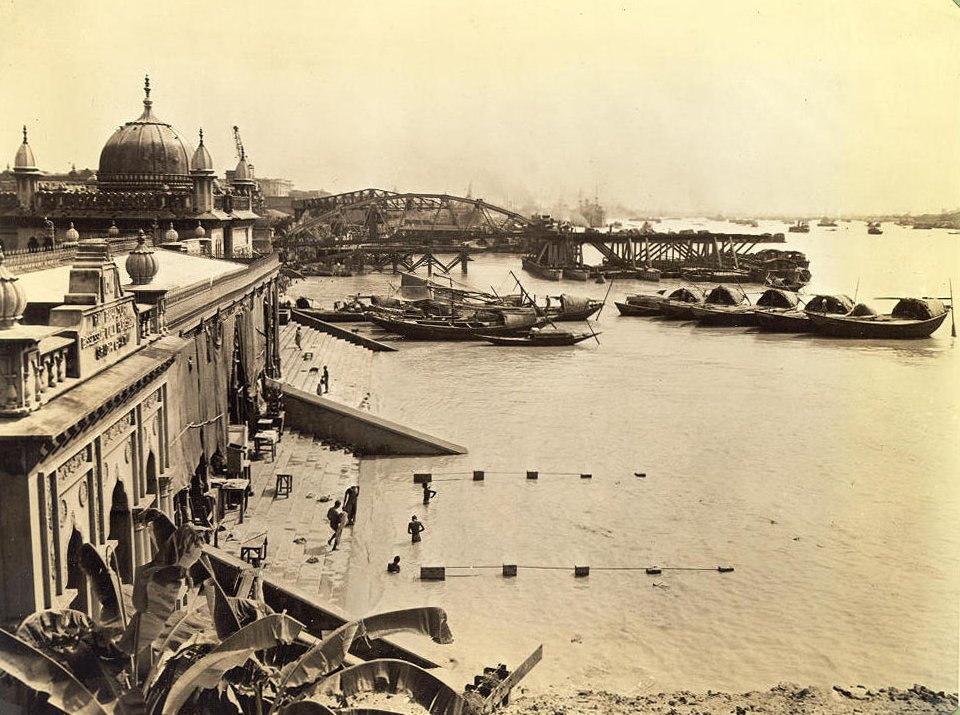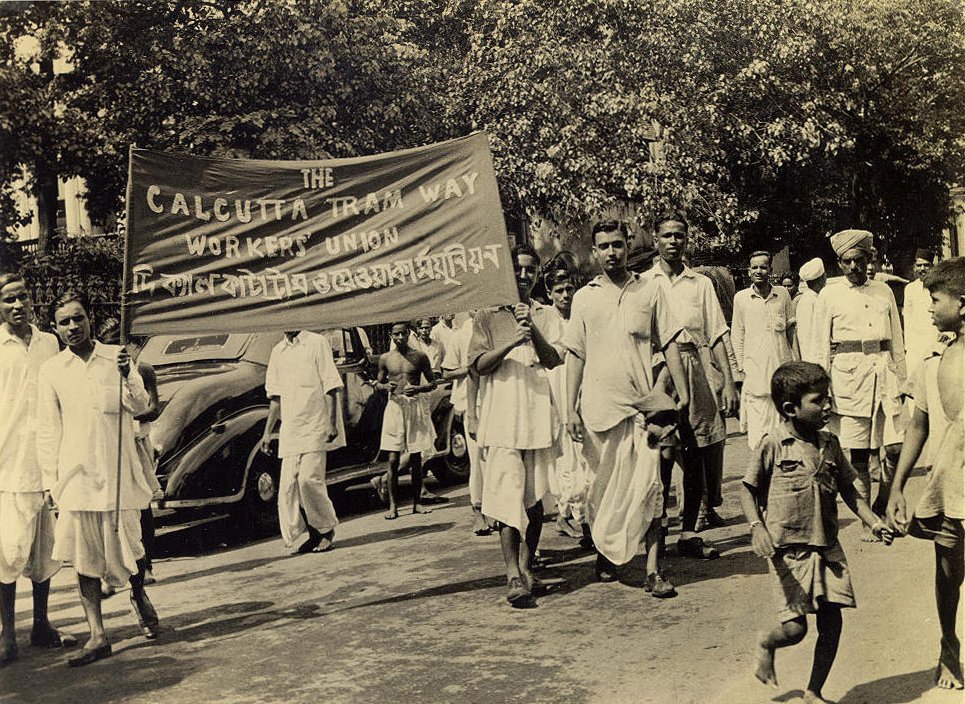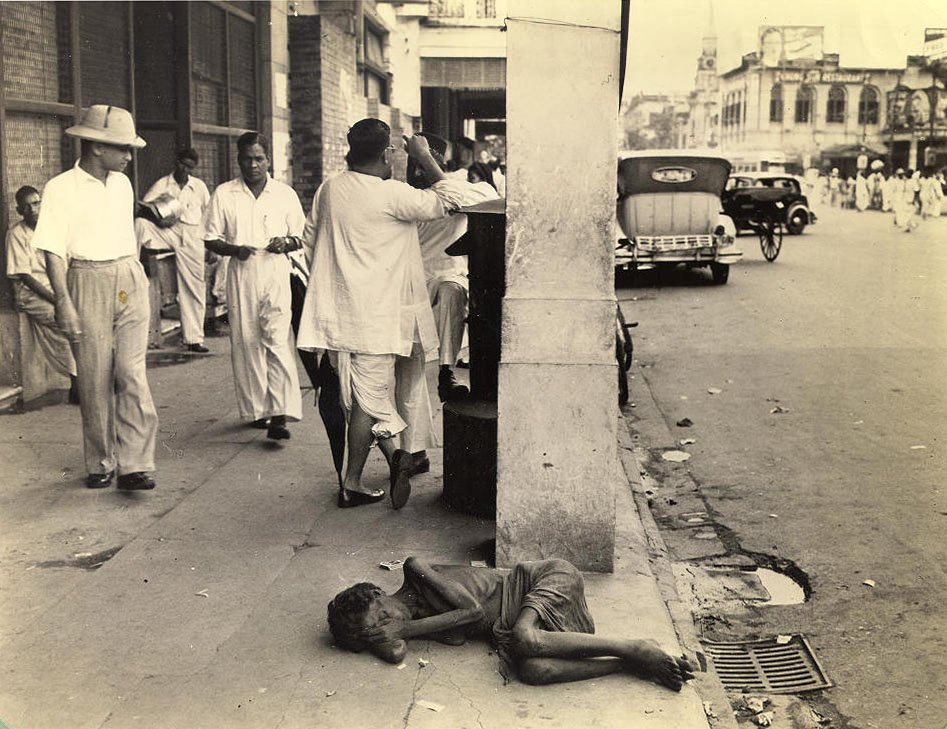Part 1 | Part 2 | Part 3 | Part 4 | Part 5 | Part 6 | Part 7 | Part 8 | Part 9
 The Hooghly river is lined with bathing ghats likke the one shown here. The troop transports in the background seem out of place in the old-world atmosphere created by the temple at left and the sampans at anchor.
The Hooghly river is lined with bathing ghats likke the one shown here. The troop transports in the background seem out of place in the old-world atmosphere created by the temple at left and the sampans at anchor.
 Street scene outside the Calcutta stock exchange. The noise is similar to the bedlam in all word exchange and many transactions (unofficial) take place in the street as shown here.
Street scene outside the Calcutta stock exchange. The noise is similar to the bedlam in all word exchange and many transactions (unofficial) take place in the street as shown here.
 Calcutta boasts the third largest cantielver bridge in the world. Its real importance, however, lies in the fact that it serves as Calcutta's gateway to the wese, being the city's only bridge spanning the Hooghly.Taking 7 years to build, it cost $10,000,000. It towers 310 feet as the city's highes structure, is 2,150 feet long with a center span of 1,500 feet. It was completed in 1942, opened in February, 1943.
Calcutta boasts the third largest cantielver bridge in the world. Its real importance, however, lies in the fact that it serves as Calcutta's gateway to the wese, being the city's only bridge spanning the Hooghly.Taking 7 years to build, it cost $10,000,000. It towers 310 feet as the city's highes structure, is 2,150 feet long with a center span of 1,500 feet. It was completed in 1942, opened in February, 1943.
 Indicative of the resumption of an age-old struggle for decent conditions is this immediate post-war picture of tram-workers on strike. The strike lasted nine days but employees won par of their demands.
Indicative of the resumption of an age-old struggle for decent conditions is this immediate post-war picture of tram-workers on strike. The strike lasted nine days but employees won par of their demands.
 The indifference of the passerby on this downtown Calcutta street to the plight of the dying woman in the foreground is considered common. During the famine of 1943, cases like this were to be seen in most every block, and though less frequent now, the hardened public reaction seems to have endured.
The indifference of the passerby on this downtown Calcutta street to the plight of the dying woman in the foreground is considered common. During the famine of 1943, cases like this were to be seen in most every block, and though less frequent now, the hardened public reaction seems to have endured.
 The Hooghly river is lined with bathing ghats likke the one shown here. The troop transports in the background seem out of place in the old-world atmosphere created by the temple at left and the sampans at anchor.
The Hooghly river is lined with bathing ghats likke the one shown here. The troop transports in the background seem out of place in the old-world atmosphere created by the temple at left and the sampans at anchor. Street scene outside the Calcutta stock exchange. The noise is similar to the bedlam in all word exchange and many transactions (unofficial) take place in the street as shown here.
Street scene outside the Calcutta stock exchange. The noise is similar to the bedlam in all word exchange and many transactions (unofficial) take place in the street as shown here. Calcutta boasts the third largest cantielver bridge in the world. Its real importance, however, lies in the fact that it serves as Calcutta's gateway to the wese, being the city's only bridge spanning the Hooghly.Taking 7 years to build, it cost $10,000,000. It towers 310 feet as the city's highes structure, is 2,150 feet long with a center span of 1,500 feet. It was completed in 1942, opened in February, 1943.
Calcutta boasts the third largest cantielver bridge in the world. Its real importance, however, lies in the fact that it serves as Calcutta's gateway to the wese, being the city's only bridge spanning the Hooghly.Taking 7 years to build, it cost $10,000,000. It towers 310 feet as the city's highes structure, is 2,150 feet long with a center span of 1,500 feet. It was completed in 1942, opened in February, 1943. Indicative of the resumption of an age-old struggle for decent conditions is this immediate post-war picture of tram-workers on strike. The strike lasted nine days but employees won par of their demands.
Indicative of the resumption of an age-old struggle for decent conditions is this immediate post-war picture of tram-workers on strike. The strike lasted nine days but employees won par of their demands. The indifference of the passerby on this downtown Calcutta street to the plight of the dying woman in the foreground is considered common. During the famine of 1943, cases like this were to be seen in most every block, and though less frequent now, the hardened public reaction seems to have endured.
The indifference of the passerby on this downtown Calcutta street to the plight of the dying woman in the foreground is considered common. During the famine of 1943, cases like this were to be seen in most every block, and though less frequent now, the hardened public reaction seems to have endured.




